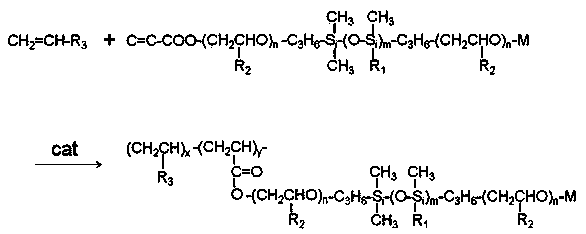Polyether modified organic silicon defoamer, and preparation method and application thereof
A polyether modification, silicone oil technology, applied in the direction of foam dispersion/prevention, can solve the problems of demulsification and bleaching oil, poor foam suppression ability and incomplete emulsification of dimethicone defoamer, and achieve stable emulsification properties. , The effect of increasing emulsion stability and good defoaming activity
- Summary
- Abstract
- Description
- Claims
- Application Information
AI Technical Summary
Problems solved by technology
Method used
Image
Examples
Embodiment 1
[0044] Add 1.5g of sodium hydroxide into the autoclave, then add 58g of initiator propenyl alcohol, and quickly press the lid of the autoclave. Vacuum at room temperature to make the reaction initial pressure reach -0.1 MPa. Press in about 50 g of EO through the ethylene oxide (EO) storage tank, turn on the stirring and heating device, and heat up the reaction. After the reaction is stable, add the remaining EO in batches, 30-40 g each time, the total amount added is 220 g, and then PO (propylene oxide) is added, 30-35 g each time, the total amount added is 112 g, and the reaction temperature is maintained at 120°C. After the reaction was complete, the temperature was lowered to 100°C. After adding the materials, perform the aging reaction until the pressure in the kettle returns to -0.1MPa, and then cool and discharge to obtain allyl alcohol polyether.
Embodiment 2
[0046] Add 1.5g of sodium hydroxide into the autoclave, then add 58g of initiator propenyl alcohol, and quickly press the lid of the autoclave. Vacuum at room temperature to make the reaction initial pressure reach -0.1 MPa. Press in about 80 g of EO through the ethylene oxide (EO) storage tank, turn on the stirring and heating device, and heat up the reaction. After the reaction is stable, add the remaining EO in batches, 40-50 g each time, the total amount added is 308 g, and the reaction temperature is maintained at 110-125 °C. After the EO reaction is complete, lower the temperature to 105-110 °C. After the feeding is completed, the aging reaction is carried out until the pressure in the kettle returns to -0.1 MPa, and the allyl alcohol polyether is obtained by cooling and discharging.
[0047] Put 100g of low-hydrogen silicone oil uc12 and 88g of the above allyl alcohol polyether in a 250 mL four-necked flask with a thermometer and an electric stirrer, vacuum distill un...
Embodiment 3
[0050] Add 1.5g of sodium hydroxide into the autoclave, then add 58g of initiator propenyl alcohol, and quickly press the lid of the autoclave. Vacuum at room temperature to make the reaction initial pressure reach -0.1 MPa. Mix 396g EO and 168g PO in the storage tank, press in about 50 g of EO / PO through the storage tank, turn on the stirring and heating device, and raise the temperature to react. After the reaction is stable, the remaining EO / PO is added in batches, 30-40 g each time, and the reaction temperature is maintained at about 115°C. After the reaction was complete, the temperature was lowered to 105°C. After the feeding is completed, the aging reaction is carried out until the pressure in the kettle returns to -0.1 MPa, and the allyl alcohol polyether is obtained by cooling and discharging.
[0051] Put 100g of low-hydrogen silicone oil uc11 and 96g of the above-mentioned allyl alcohol polyether in a 250 mL four-necked flask with a thermometer and an electric sti...
PUM
 Login to View More
Login to View More Abstract
Description
Claims
Application Information
 Login to View More
Login to View More - R&D
- Intellectual Property
- Life Sciences
- Materials
- Tech Scout
- Unparalleled Data Quality
- Higher Quality Content
- 60% Fewer Hallucinations
Browse by: Latest US Patents, China's latest patents, Technical Efficacy Thesaurus, Application Domain, Technology Topic, Popular Technical Reports.
© 2025 PatSnap. All rights reserved.Legal|Privacy policy|Modern Slavery Act Transparency Statement|Sitemap|About US| Contact US: help@patsnap.com



